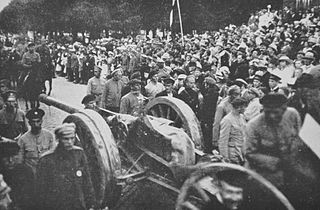
Back حرب الاستقلال اللاتفية Arabic Latviya İstiqlaliyyət müharibəsi Azerbaijani Барацьба за незалежнасць Латвіі Byelorussian Вайна за незалежнасьць Латвіі BE-X-OLD Guerra de la Independència de Letònia Catalan Lotyšská osvobozenecká válka Czech Lettiske krig for uafhængighed Danish Lettischer Unabhängigkeitskrieg German Latva milito de sendependeco Esperanto Guerra de Independencia de Letonia Spanish
| Latvian War of Independence | ||||||||||
|---|---|---|---|---|---|---|---|---|---|---|
| Part of Russian Civil War, Polish–Soviet War and Estonian War of Independence | ||||||||||
 The North Latvian Brigade entering Riga in 1919 | ||||||||||
| ||||||||||
| Belligerents | ||||||||||
| 1918–April 1919 | 1918–April 1919 | |||||||||
| April–July 1919 | April–July 1919 | April–July 1919 | ||||||||
July 1919–1920
| October–December 1919 | July 1919–1920 | ||||||||
| Commanders and leaders | ||||||||||
|
|
|
| ||||||||
| Strength | ||||||||||
|
| |||||||||
| Casualties and losses | ||||||||||
| ||||||||||
| ||||||||||
| History of Latvia |
|---|
 |
| Chronology |
|
|
The Latvian War of Independence (Latvian: Latvijas Neatkarības karš), sometimes called Latvia's freedom battles (Latvijas brīvības cīņas) or the Latvian War of Liberation (Latvijas atbrīvošanas karš), was a series of military conflicts in Latvia between 5 December 1918, after the newly proclaimed Republic of Latvia was invaded by Soviet Russia, and the signing of the Latvian-Soviet Riga Peace Treaty on 11 August 1920.[12]
The war can be divided into a few stages: Soviet offensive, German-Latvian liberation of Kurzeme and Riga, Estonian-Latvian liberation of Vidzeme, Bermontian offensive, Latvian-Polish liberation of Latgale.
The war involved Latvia (its provisional government supported by Estonia, Poland and the Western Allies—particularly the navy of United Kingdom) against the Russian SFSR and the Bolsheviks' short-lived Latvian Socialist Soviet Republic. Germany and the Baltic nobility added another level of intrigue, initially being nominally allied to the Nationalist/Allied force but attempting to jockey for German domination of Latvia. Eventually, tensions flared up after a German coup against the Latvian government, leading to open war.
Following a cease-fire, a ploy was developed by the Germans, nominally dissolving into the West Russian Volunteer Army led by Gen. Pavel Bermont-Avalov. This West Russian Volunteer Army included Germans and former Russian prisoners of war nominally allied with the White Army in the Russian Civil War, but both Bermondt-Avalov and von der Goltz were more interested in eliminating the nationalists than fighting the Bolsheviks.
Certain episodes of the Latvian Independence War were also part of the Polish-Soviet War, particularly the Battle of Daugavpils.
- ^ "Letland §5. Geschiedenis". Encarta Encyclopedie Winkler Prins (in Dutch). Microsoft Corporation/Het Spectrum. 2002.
- ^ Latvijas Atbrīvošanas kaŗa vēsture Archived 2023-10-18 at the Wayback Machine (in Latvian)
- ^ Colonel Jaan Maide. Ülevaade Eesti Vabadussõjast (1918–1920) (Overview on Estonian War of Independence) (in Estonian). Archived from the original on 2010-08-22.
- ^ Wright, pp. 543-544
- ^ [1] Archived 2010-08-22(Date mismatch) at the Wayback Machine (in Estonian)
- ^ [2] Archived 2015-12-22 at the Wayback Machine (in English)
- ^ Mangulis, Visvaldis. Latvia in the Wars of the 20th Century. Princeton Junction: Cognition Books, 1983, xxi, 207p.
- ^ [3] Archived 2015-12-22 at the Wayback Machine (in English)
- ^ Latvijas Brīvības cīņas, page 15 (in Latvian)
- ^ [4] Archived 2022-11-02 at the Wayback Machine (in Latvian)
- ^ Hans von Rimscha, Hellmuth Weiss (1977). Von den baltischen Provinzen zu den baltischen Staaten 1918-1920. J. G. Herder-Institut. p. 61.
- ^ (in Latvian)Freibergs J. (1998, 2001) Jaunāko laiku vēsture 20. gadsimts Zvaigzne ABC ISBN 9984-17-049-7